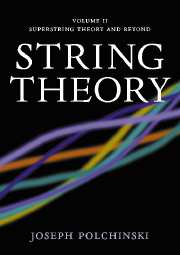Book contents
- Frontmatter
- Contents
- Foreword
- Preface
- Notation
- 10 Type I and type II superstrings
- 11 The heterotic string
- 12 Superstring interactions
- 13 D-branes
- 14 Strings at strong coupling
- 15 Advanced CFT
- 16 Orbifolds
- 17 Calabi–Yau compactification
- 18 Physics in four dimensions
- 19 Advanced topics
- Appendix B Spinors and SUSY in various dimensions
- References
- Glossary
- Index
14 - Strings at strong coupling
Published online by Cambridge University Press: 26 February 2010
- Frontmatter
- Contents
- Foreword
- Preface
- Notation
- 10 Type I and type II superstrings
- 11 The heterotic string
- 12 Superstring interactions
- 13 D-branes
- 14 Strings at strong coupling
- 15 Advanced CFT
- 16 Orbifolds
- 17 Calabi–Yau compactification
- 18 Physics in four dimensions
- 19 Advanced topics
- Appendix B Spinors and SUSY in various dimensions
- References
- Glossary
- Index
Summary
Thus far we have understood string interactions only in terms of perturbation theory — small numbers of strings interacting weakly. We know from quantum field theory that there are many important phenomena, such as quark confinement, the Higgs mechanism, and dynamical symmetry breaking, that arise from having many degrees of freedom and/or strong interactions. These phenomena play an essential role in the physics of the Standard Model. If one did not understand them, one would conclude that the Standard Model incorrectly predicts that the weak and strong interactions are both long-ranged like electromagnetism; this is the famous criticism of Yang–Mills theory by Wolfgang Pauli.
Of course string theory contains quantum field theory, so all of these phenomena occur in string theory as well. In addition, it likely has new nonperturbative phenomena of its own, which must be understood before we can connect it with nature. Perhaps even more seriously, the perturbation series does not even define the theory. It is at best asymptotic, not convergent, and so gives the correct qualitative and quantitative behavior at sufficiently small coupling but becomes useless as the coupling grows.
In quantum field theory we have other tools. One can define the theory (at least in the absence of gravity) by means of a nonperturbative lattice cutoff on the path integral. There are a variety of numerical methods and analytic approximations available, as well as exactly solvable models in low dimensions. The situation in string theory was, until recently, much more limited.
In the past few years, new methods based on supersymmetry have revolutionized the understanding both of quantum field theory and of string theory.
- Type
- Chapter
- Information
- String Theory , pp. 178 - 227Publisher: Cambridge University PressPrint publication year: 1998
- 1
- Cited by



